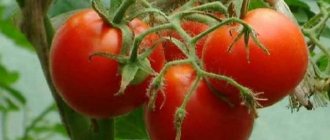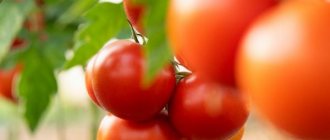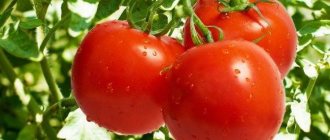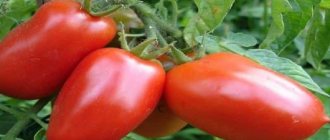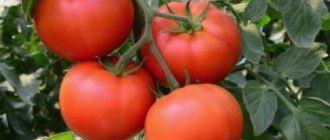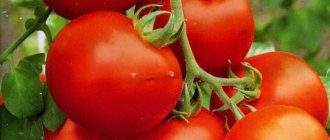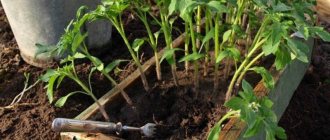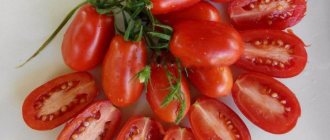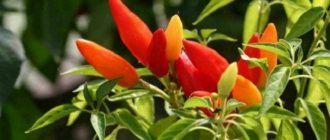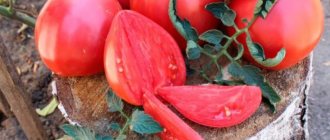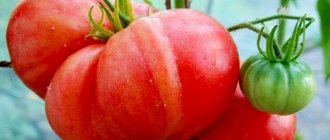The Ogorodnik tomato is a good mid-season variety, which is valued because it is convenient to preserve; it makes tasty and beautiful winter preparations, as well as fresh salads and vegetable dishes.
| Height | Landing location | Ripening time | Fruit color | Fruit size | Origin | Fruit shape |
| Medium height | Greenhouse, Open ground | Mid-season | Reds | Average | Variety | Flat-round |
Description of the variety
The “Ogorodnik” variety is endowed with the following indicators:
- the tomato belongs to varieties with early ripening, the fruits can be harvested 95-105 days after germination;
- the bushes are of the determinant type; they can rise in height by 60 cm in open ground and 120-150 in a greenhouse;
- a large number of shoots do not form on the plants, resulting in thickening;
- the bush is average, has medium-sized leaves;
- leaves are small, rich green in color;
- fruit shape is round;
- the weight of tomatoes is large - up to 300 g;
- up to 6 fruits can ripen in a cluster;
- ripe tomatoes of bright red color;
- the skin is shiny, dense, not subject to cracking;
- the pulp is sweet, fleshy, dense;
- fruits can easily be transported over long distances and do not deteriorate during long-term storage;
- tomatoes are resistant to the following infections: late blight, fusarium, stolbur and tobacco mosaic virus;
- The variety has a high yield - from 1 m² you can harvest up to 6 kg of tomatoes.
Advantages and disadvantages of the variety
Like most varieties from Russian breeders, grown using special methods to obtain resistance to weather conditions and pests, Ogorodnik turned out to be a version in which positive properties prevail over minor negative aspects. Russian forums for experienced and novice vegetable growers talk about the positive qualities of the varietal material, bush and harvest:
- the bush is tall, needs staking, but makes harvesting easier and requires only minor pinching, unlike other determinate varieties;
- tomatoes with excellent taste, minimal dry matter content and sugar content of more than 4.4%;
- tomatoes have an absolutely traditional shape, ideal smooth glossy skin, a wonderful rich red hue - everything that is required for lovers of classic, tasty and inexpensive varieties;
- collected before frost, in a state of technical ripeness, they are able to ripen independently in the correct storage conditions, and at the same time retain their presentation and useful substances;
- the variety tolerates transportation well and can become a good option for industrial cultivation on a large and small scale, due to its low cost and excellent yield;
- when canning, it retains its taste characteristics, and when preparing juices and tomatoes, it provides the necessary consistency of the product, thanks to the rich sugar content and low dry matter content:
- There are relatively few seeds in the fruits, which somewhat complicates the collection of seed material, but improves table suitability.
Note!
Experienced vegetable growers who have been working with Ogorodnik for many years note that with proper planting of seedlings and compliance with the climatic regime for their cultivation, fruits in open ground can reach 250-300 g. And if some ovaries are removed and the most viable ones are left, the result is giant tomatoes weighing over half a kilogram and high content of useful substances.
How to grow tomato seedlings yourself
Let's look at what you need to pay attention to in order to grow seedlings of the "Ogorodnik" variety yourself.
Did you know? To make green tomatoes ripen faster, it is recommended to store them with apples or ripe tomatoes. They release ethylene, which helps this process.
Optimal timing for sowing
Seeds are sown for seedlings approximately 60 days before the intended planting in the ground. This period is enough for young plants to gain strength for full growth and harvest formation.
The soil
The choice of soil for a good harvest must be taken seriously; you need to choose high-quality soil; it is better to avoid garden soil, as it may contain pathogenic organisms. To minimize the chance of disease, it is recommended to disinfect the soil. To do this, water it with a fresh solution of potassium permanganate (take 3 g of potassium permanganate per 10 liters of water). Add 1 liter of solution to each well. As a preventative measure, such actions are carried out 3 times during the season.
Important! Incorrectly selected soil will not only significantly reduce the yield, but may even prevent the plant from fully growing.
Growing container
For growing future seedlings, any containers that have holes for drainage are suitable. For these purposes, you can use plastic containers, yogurt jars, or any container that can hold soil.
Seed preparation
Before sowing, it is recommended to soak the seeds in a solution of potassium permanganate, rinse them in clean water and dry them without fail. To stimulate root formation, the seeds can be soaked in a growth stimulator; a similar solution can be purchased at any agricultural store.
Sowing seeds
The planting pattern is as follows: 50×50 cm, planting density up to 4 plants per 1 m². The seeds are sown in containers with soil, deepened a little and sprayed with water; these manipulations are carried out in March. For seedlings to appear, the room temperature must be within +24 ºС. The containers are placed in bright light, and it is important to rotate them occasionally for uniform development.
Seedling care
After transplantation, care consists of:
- timely watering;
- getting rid of weeds;
- feeding;
- preventive measures to protect against diseases and pests.
It is important to understand that seeds need heat and light to germinate.
For growth and photosynthesis, you need to install containers with seeds in a place where there is a lot of sun. The air temperature should be within +26 ºС. Every 3 days, water and fertilize the seedlings with organic fertilizers. Did you know? Unripe tomatoes contain a toxic substance - solanine. If you consume more than 2 kg of green fruits, you can get poisoned. Solanine can also be found in ripe tomatoes that have been exposed to light for a long time.
Hardening of seedlings
For better growth and increased immunity, seedlings need to be hardened off before planting. To do this, 7 days before the expected date, they are taken outside for a couple of hours. This needs to be done for several days in a row.
Tomato variety Parsley gardener
Tomatoes are one of the most popular vegetable crops grown in home gardens. Getting a rich harvest of this healthy and tasty product has become easier with the advent of disease-resistant, unpretentious varieties.
The Parsley gardener tomato, recently created by Altai breeders, included in the State Register of the Russian Federation in 2013, is already well known to vegetable growers and has become a favorite of many household plots.
Description of the variety
Photo of tomato:
The Parsley gardener tomato variety was bred in Siberia, so it is suitable for all regions, including the northern ones. Parsley does not require frequent watering and bears fruit well even in dry conditions.
The tomato belongs to the hybrid varieties of the superdeterminate type. The bushes are low-growing, standard, up to 60 centimeters high. When grown in a greenhouse, the plant can reach a height of 1-1.2 meters.
The Parsley gardener tomato is a mid-early variety and actively bears fruit from July to October. It is distinguished by uniform ripening of fruits. A low-growing, lush bush with an abundance of ovaries and covered with succulent dark green leaves. Large clusters of fruit are formed through each leaf.
Tomato fruits are a rich red-pink color, oblong oval in shape, reminiscent of the cap of Parsley - a character in Russian fairy tales. The variety received its original name precisely because of their shape. This variety looks very beautiful when fruiting.
A mature vegetable weighs between 180-200 grams, some specimens can weigh up to 300 grams. The fruits are strong, fleshy, and can be stored fresh for a long time. The tomato pulp is juicy, dense, tastes sweet, and has a high sugar content.
Productivity
The Parsley gardener tomato is distinguished by its abundant fruiting. During the season, you can harvest 4-6 kilograms of tomatoes from one bush. It is recommended to collect ripe fruits regularly to stimulate the next ones. Tomatoes with a dense consistency are perfectly stored and retain their presentation when transported over long distances.
Tomatoes of this variety are widely used in cooking for making sauces, juices, ketchups, tomato paste, pickling and canning. Due to their dense consistency, they practically do not lose their shape during heat treatment. Fresh tomatoes are very tasty.
Reviews from vegetable growers
The Parsley gardener tomato has earned positive reviews from gardeners, who distinguish it favorably from other varieties.
In their opinion, the tomato has valuable characteristics:
- has a long fruiting period;
- does not require pinching;
- bears fruit in the garden regardless of the weather;
- tolerates dry periods well;
- resistant to many tomato diseases, does not require additional treatments for diseases;
- universal in use.
Among the disadvantages of the variety, gardeners cite the need to comply with growing conditions and rules. Some vegetable growers who grew tomatoes of the Parsley Ogorodnik variety in greenhouses also consider poor pollination in greenhouse conditions to be a disadvantage.
Experienced gardeners note that the Parsley gardener variety has one more feature - the ability to grow by cuttings. To do this, you can use stepsons and tops of branches, which are placed in water or moist soil for 10 days. Thus, it becomes possible, with a minimum number of seedlings, to constantly increase it, correspondingly increasing the fruiting period.
Parsley gardener allows you to feast on your tomatoes all winter. To do this, you need to leave it indoors in a container, constantly break off and root the shoots. There will always be fresh tomatoes on the table, and by spring, mature plants.
Growing seedlings
You can grow tomatoes in a greenhouse and in a garden bed. The best conditions for plant growth and development are fresh air and sunlight. When planted in open ground, the yield of the variety is much higher than in a greenhouse.
Sowing seeds for seedlings
It is recommended that the gardener sow the Parsley tomato seeds for seedlings 55-60 days before the intended planting in the ground and 120 days before the fruit begins to ripen. In the middle zone, seeds are sown for seedlings in late February and early March. If the manufacturer has not treated the seeds with a fungicide, it is recommended to disinfect them yourself in a one percent solution of potassium permanganate.
To do this, seeds wrapped in a gauze bag are dipped into a container with a solution for 20-30 minutes.
In order for the seedlings to sprout faster, you need to let the seeds “hatch”. To do this, it is recommended to put them in a warm place near the radiator, wrapped in a napkin, gauze or cotton cloth and placed in a plastic bag. It is necessary to periodically check that the material is always damp. After 4-5 days, the first shoots usually appear.
Before sowing the hatched seeds, you must:
- Prepare suitable containers: small pots, plastic containers, jars up to 0.5 liters.
- Pour a drainage mixture into the bottom: expanded clay or eggshells.
- Fill containers with moistened nutrient mixture.
- Use a pencil to make indentations in each container.
- Sow 2 seeds in each container in case one dies.
- Sprinkle with a layer of earth no more than 1 centimeter thick, moisten if necessary.
- Cover the containers with film or glass and place them on a lighted windowsill.
Temperature and lighting
First you need to maintain a temperature of 23-25°C. With the appearance of the first shoots, it is recommended to reduce it to 17-19°C. To prevent the seedlings from stretching out, the illumination should be at least 12 hours a day. For this, fluorescent lamps are used. The seedlings turn out dark green, squat, curly. It is picked at the stage of two true leaves.
Well-lit, fertile areas with a southern slope are suitable for growing mid-season tomatoes. For better survival in the soil, seedlings must be hardened off. To do this, for 7-8 days before planting, it is taken out into the open air for 2-6 hours.
The timing of planting tomatoes of the Parsley gardener variety in the ground is determined depending on local climatic conditions. In the middle zone, mid-season tomato varieties are usually planted under film on April 20-May 5, and on the ridge - May 20-June 10.
The best predecessors for tomatoes are legumes, cabbage, and cucumbers. Before planting seedlings, dig up the soil and apply complex fertilizers. In some cases, the soil is treated with a solution of Bordeaux mixture (2-5 grams per 10 liters of water) for disinfection.
Holes are dug according to the pattern 70x30 centimeters. Seedlings are planted in prepared holes, the root part of the stem is covered with soil and watered abundantly. When planting seedlings in a permanent place, place up to 6 plants per 1 square meter.
How to care for tomatoes
To obtain the desired harvest and proper plant growth, you need to know how to properly care for tomatoes.
Determinate varieties include such varieties as: “Dubok”, “Torbey”, “Gina”, “Stolypin”, “Belyi Naliv”, “Tatyana” and “Sanka”.
Watering
Tomatoes are demanding when it comes to watering. To avoid damaging the trunks and leaves, it is better to choose drip irrigation. Young bushes are watered once a week with 1 liter of water per bush. Adult plants should receive water daily in hot and dry weather. On cloudy days - no more than once every 3 days.
Feeding
On average, it is recommended to fertilize tomatoes up to 4 times per season. Any mineral complex with nitrogen and potassium, diluted mullein or bird droppings are suitable for this. Natural fertilizers are diluted as follows: 0.5 liters of manure per 10 liters of water. It is important to let it sit for several days before use. In addition, one-time treatments with an aqueous solution of superphosphate can be carried out.
Important! Fertilizers should be selected depending on the type of tomatoes. The missing elements need to be added to the soil to make it as suitable as possible for tomatoes.
Stepsoning
The formation of a bush of this variety can be done in two ways:
- 1 stem for growing in open ground;
- 3 stems for greenhouse growth;
- with transfer of the growth point to a side shoot in greenhouses.
Tomato planting scheme
Soil care
“Ogorodnik” tomatoes love moisture, so that there is enough of it in the ground, they also regularly weed out weeds, which not only pollute the soil, but also draw water and nutrients from it. To prevent moisture from quickly evaporating after watering, it is recommended to loosen the soil. Ideally, mulch can be placed between the rows to minimize evaporation and the appearance of weeds. This could be mown grass or hay, or rather anything that will not allow the sun's rays to pass through.
Tying up a bush
To prevent the branches and trunk from breaking under the weight of the fruit, it is recommended to tie up the tomato bushes. This is done quite simply: they drive a peg about 1 m high at a distance of 15 cm from the bush and tie the bush to it using a rope.
Find out how to properly tie tomatoes.
Preventative treatment
In order to minimize the chance of crop disease, it is recommended to know some nuances:
- use good soil for growing, regularly fertilize tomatoes and ensure proper watering;
- completely healthy plants resist diseases and problems more easily;
- systematically remove weeds and debris to minimize the number of places where insects can breed;
- Clean gardening tools and equipment to ensure they do not transmit disease;
- remove diseased plants in a timely manner to reduce the spread of the problem;
- Avoid composting diseased leaves or plants;
- “Gardener” is recommended to water only by the drip method.
Tomato Parsley gardener, variety characteristics, yield, reviews from summer residents
Hybrid tomato varieties are valued for their high productivity, unpretentiousness and disease resistance. Many of these types of tomatoes have been bred. A worthy place among them is occupied by Petrusha the gardener.
Content:
Selecting the most delicious tomatoes for planting, selection criteria
To choose the best variety, you need to consider various factors.
Features of the bush and fruits
Depending on the nature of the development of the ground part, two types of tomatoes are distinguished:
- indeterminate
- deterministic
The former are distinguished by their tall growth and predominantly large fruits. They bloom and bear fruit several times a season. Due to the altitude, late blight is less common. Tomatoes ripen later. Plants require more care.
Determinate varieties are low-growing, their height rarely exceeds 1 m. They bloom once. They are distinguished by fast and abundant fruiting. Tomatoes are medium and small. Suitable for sale and home preparation.
In turn, deterministic varieties are divided into 3 types:
- superdeterministic
- semi-deterministic
- standard
Climatic conditions
It is necessary to take into account temperature characteristics and soil composition. Preference should be given to those varieties that in a given area will produce the best harvest with the least effort and expense.
Thus, indeterminate species are not planted in the north. Such tomatoes do not have time to ripen in cold climates. In the middle zone they are grown in greenhouses, and in the south - in open ground.
Determinate varieties are suitable for greenhouse planting in cold areas and open ground in warmer regions.
Ripening time
According to the speed of ripening, tomatoes are divided into:
- early ripening
- mid-season
- late ripening
Gardeners from the north are advised to choose early-ripening varieties in order to have time to harvest. In the south, it is better to choose late-ripening tomatoes. Thanks to this, a varied harvest is obtained, and the harvest time is extended.
Purpose of cultivation
Depending on where the tomatoes are going (for sale, for preparations, for salads), they are guided by the following signs:
- form
- size
- transportability
- keeping quality
- characteristics of pulp and skin
Drop off point
Hybrid varieties are suitable for greenhouse cultivation. They produce vigorous shoots and are distinguished by their early maturity and stability. Varietal tomatoes are also planted outside. But their only advantage is the ability to get seeds.
The history of the appearance of the Parsley gardener tomato variety
Let's consider one of the varieties popular among summer residents - to make it easier for you to determine whether this variety can be grown on your site.
The Parsley gardener tomato appeared quite recently. It was bred by Altai amateur breeders from several parental forms.
Thanks to its stability, rapid ripening and high fruiting, the variety is loved by summer residents from all over Russia. Now it is grown in the south. Experiments with greenhouse plantings also produce excellent results.
Characteristics of the plant and its fruits, productivity
The plant belongs to the superdeterministic type. It is a dense, low-growing bush up to 60 cm high. In the greenhouse, the shoots stretch up to 100-120 cm. The leaves are dark green, slightly corrugated. Lots of ovaries.
The fruits are bright scarlet, oblong in shape. Average weight 180-200 g. At the beginning of fruiting, the weight reaches 300 grams. The taste of tomatoes is sweet. The pulp is fleshy and juicy.
Tomatoes are well transported, stored for a long time and do not crack. Brushes are formed through each leaf. 4-6 kg of fruits are collected from the bush per season.
The active fruiting phase is from July to October. The best yield is achieved by following the rules of planting and care.
The fruits are universal in use. They are used in salads, canning, juices and sauces.
Peculiarities of caring for the Parsley tomato gardener, is it necessary to plant stepsons?
The plant reproduces in two ways:
Seeds are sown in late February-early March. The soil should be moist and loose. The sprouts sprout after the appearance of 2 true leaves.
Within two weeks before moving to a permanent place, the plants are hardened off in the fresh air. The sprouts are transferred to open soil in May, and to a greenhouse or hotbed in April. Bushes are planted in a checkerboard pattern, 6 pieces per square meter. m.
Stepchildren or upper shoots are suitable for cuttings. They are placed in water or moist soil for 10 days. After rooting, they are transplanted to a permanent place.
When planting, it is important to consider that Parsley gardener prefers fresh air and sunlight. Therefore, it is preferable to plant it in open ground. This way you can get a richer harvest.
Before planting, add 1 tbsp to the hole. l. superphosphate. After 10 days, the plant is fed with complex fertilizer for tomatoes.
Harvesting
Thanks to gradual ripening, you can enjoy the taste of fresh tomatoes of the Ogorodnik variety for a fairly long period of time. Despite the density of the skin, for transportation over long distances it is better to remove unripe fruits. For them to turn red, it is enough to keep them in the sun for several days. You can harvest in any available container. It is better to store in a cool place.
Read more about how to properly store tomatoes at home.
The Ogorodnik variety is the optimal solution for growing in different regions. If you take into account all the care features, then after a little more than three months, you can harvest a lot of delicious tomatoes.
Formation of determinate tomatoes, video
If you grew Ogorodnik tomatoes, please write whether you liked them or not. What was the yield and taste of the fruits like under your climatic conditions? If possible, attach a photo of the entire bush or individual fruits you grew to your comment.
Your reviews of the Ogorodnik tomato and additions to the description will help many tomato lovers evaluate this variety more objectively and decide whether it is worth planting or not.
This is a natural variety of tomato. Therefore, we recommend taking seeds from a ripe fruit and using them for planting in subsequent seasons.
Reviews about the variety from those who planted
Remarkable marketable appearance and excellent taste allowed the Ogorodnik tomato to be in demand in the consumer market. If you have a large greenhouse structure and a large garden plot, you can safely cultivate the “Ogorodnik” tomato for sale.
Those who have not yet grown the tomato variety “Ogorodnik” should definitely plant it. Thanks to the extended fruiting period, you can collect and enjoy fresh fruits before the onset of frost.
Tomato varieties for growing in a greenhouse:
Pest and disease control
Parsley gardener is a variety that is less susceptible to root rot and late blight. However, preventive measures should not be neglected. Late blight is a formidable enemy of tomatoes; plants should not be left without help. Strict adherence to agricultural technology will help - absence of thickening, timely watering and fertilizing, ventilation of greenhouses, spraying with biological products (Barrier, Barrier, Fitosporin) or folk compositions (herbal or onion infusions, whey). To prevent the appearance of blossom end rot, use wood ash and dolomite flour and apply them as top dressing.
Compliance with agricultural cultivation techniques guarantees the vegetable grower a high-quality harvest
Bush care
Next, the tomato bushes will need the following care:
- Regular, moderate watering, exclusively for the bush. Do not allow the soil layer to dry out. For irrigation, only warm, settled water is recommended;
- They loosen the soil in a timely manner, and also weed the beds to remove weeds;
- As they grow, the bushes are tied to a reliable support;
- Lead the bush into one or two stems, removing all unnecessary stepsons;
- Thanks to fertilizing, the quality characteristics of fruits and productivity are improved. To increase productivity, containers filled with liquid manure are placed in greenhouse structures. Since nitrogen from the air is better absorbed by leaves and stems, this method can replace foliar feeding.
